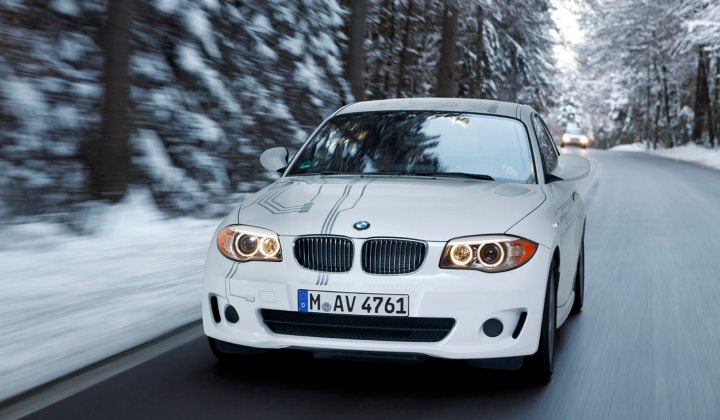Maverick Life
BMW ActiveE: The strong and silent type…

Is the electric car really a viable alternative to the growing number of hybrid cars – or even to an emerging generation of small-engined, highly sophisticated and ultra-frugal petrol-powered models? BMW thinks so – and it built more than a thousand ActiveE prototypes to prove the point. DEON SCHOEMAN drives the Bavarian stealth machine.
I’m an early riser by necessity, rather than by choice. It means that whatever’s parked in my driveway gets started up at the kind of hour when most honest folk are still snuggly tucked into bed.
If that car happens to be something exotic, like the Audi R8 I had on test recently, the aggressive snarl of the high-performance V8 can be heard the proverbial mile away – and I’m sure my neighbour will actually feel his home’s foundations shake, and hear the window panes rattle. I feel his pain.
This week, my neighbour enjoyed his best sleep in weeks – sheer, uninterrupted bliss. And if he had, by chance, been awake when I left for the office well before the crack of dawn, the loudest noise he would have heard would have been the brief but solid clunk of the driver’s door being closed – and nothing else.
He would not have heard me start up the car, nor reversing out of the driveway, or even accelerating gently down the road. That’s because I wasn’t driving a normal car, with a normal engine. I was behind the wheel of the BMW ActiveE – an all-electric, battery-powered car that makes less noise than a vacuum cleaner.
From a South African, everyday motoring perspective, electric cars are the stuff of fancy. Yes, plug-in electric vehicles (or EVs) like the Nissan Leaf are flying the EV flag in first-world markets. But in the looming shadow of load-shedding, created by a sagging electricity grid mostly fed by dirty coal-fired power stations, fleets of electric cars seem about as probable as Jacob Zuma selling off Nkandla at a charity auction.
Which makes the experience of driving BMW’s ActiveE all the more intriguing – a taste of what could become the motoring future, if not perhaps exactly in the shape presented here.
The ActiveE is not a production model. It’s an advanced prototype, based on the now-previous generation, E87 1-Series Coupé, but equipped with a full-electric, battery-powered drivetrain that will, in essence, be used by BMW’s next-generation plug-in electric vehicle, the i3.
BMW built more than a thousand ActiveE’s for field trials in several countries around the world – a kind of extended durability test that allowed the marque to subject the drivetrain to a wide range of real-world conditions. The lessons learnt from these trials will be used to improve the drivetrain before it debuts in the i3 later this year – and, in South Africa, in 2014.
The example I’m driving is left-hand drive and sports Munich plates. It also has some bold graphics proclaiming its EV identity. But for the rest, it could be any slightly older 1-Series, and for the most part, it doesn’t attract a lot of attention from fellow motorists.
One of the reasons is that, at least as far as other road users are concerned, there is nothing obviously electric about the ActiveE. Of course, they won’t notice the BMW’s complete lack of engine noise above the sound of their own drivetrains, sound systems and cellphone conversations. And the ActiveE is a brisk performer, so there’s nothing unusual about its agile progress in town or on the open road, either.
But life behind the wheel of the ActiveE is a sometimes disconcerting mix of the ordinary and radical. Ordinary because all the major controls and interfaces are identical to those of a normal petrol car: steering wheel, accelerator, brake pedal, shift lever. But radical because the actual driving experience is actually very, very different.
It starts with the lack of familiar noises. Press the start button, and nothing happens – at least not in aural terms. Yes, there are some ignition lights, and the needle of the charge indicator (occupying the space usually reserved for the rev counter) comes alive. But the ActiveE remains as silent as a car with a dead battery – no whirr of the starter, not the rasp or growl of an internal combustion engine being woken up.
Select ‘D’ for Drive, just as you would in an auto gearbox-equipped car, and the ‘D’ in the instrument binnacle will confirm that the ActiveE is ready for action. But still, there’s not a sound. And then, as you, with some trepidation, gingerly depress the accelerator, the BMW reacts – and with enthusiasm, too.
The throttle action is a bit stiffer than expected, but the response is instantaneous as the electric motor straddling the rear axle is fed its current from the car’s high-voltage lithium-ion batteries. Floor the accelerator pedal, and the ActiveE feels – yes, you better believe it – sporty, easily leaving other road users floundering in its zero-emissions wake.
The electric motor drives the rear wheels directly, without the need for a gearbox. It delivers 125kW and 249Nm – figures more than comparable with 1.6-litre or 1.8-litre four-cylinder petrol engines. And the power is delivered with zero delay.
Progress is effortless and completely intuitive. There are no gears to change, and the cruise control will stick to the chosen speed, almost regardless of gradient.
Come off the throttle completely, and the electric motor becomes a 60kW generator, feeding electricity to the batteries, and retarding the progress of the BMW with far greater force than a trailing throttle would in a petrol car. In fact, if you time it correctly (and if you’re not going too fast) there’s no need to brake at all.
If you keep the accelerator partly engaged, the ActiveE will freewheel down hills, rather than rapidly losing momentum, but the generator effect of the electric motor will be greatly diminished. And believe me, you soon learn to use every opportunity to replenish the batteries – because for all its advanced tech, the ActiveE’s operating range is limited by petrol car standards.
BMW has packed the car with as many batteries as it possibly could in the interests of a viable operating range, while still retaining an element of practicality. Battery packs occupy the spaces usually reserved for the engine and the petrol tank. The engineers have even wedged batteries into the transmission tunnel.
But batteries are heavy – and as a result, the ActiveE weighs 360kg more than a 135i. They’ve been arranged to retain the BMW-typical 50/50 front/rear weight distribution, but a small car weighing 1,815kg feels awkward when you’re cornering with some momentum, or trying to slow down fast.
As for range, the official BMW claim is 160km on a full charge, but take that distance with pinch of organic salt. Much depends on driving style and traffic conditions, on ambient temperature and on how the batteries are treated.
Our test car refused to show a range of more than 90km, even after 10 hours of charging. And if you drive with a measure of enthusiasm, in urban traffic, the available range will be cut even shorter. An EcoPro mode will eke out a few kays more by softening throttle response and limiting resource consumption for ancillaries such as the climate control.
BMW has equipped the ActiveE with several ways to monitor battery charge and range. What used to be the fuel gauge, for instance, now shows the battery charge status. You can call up the range on trip computer, and the centrally mounted colour display will provide a graphical representation of charge action, battery status and even time-based electricity consumption (in kWh/litre).
I suppose it’s a mindset – in my petrol-powered car, I wouldn’t dream of letting the fuel level run down to the point where I only had an indicated range of 30km. In the ActiveE, that 30km represents a battery charge level of at least 25%.
The problem, of course, is that there aren’t any Plan B options if you run out of battery power. You won’t find too many wall plugs on the side of the road, and there’s no portable way to replenish those batteries with an emergency charge. It means that every trip has to be premeditated and carefully planned.
In Europe, the intention is to establish a network of forecourt-like charge stations, where quick-charge outlets will allow batteries to be charged in a reasonable time frame. But I can’t imagine that becoming a reality here in the near future – and certainly not outside major metro areas.
BMW says its research shows that most potential electric vehicle buyers don’t commute further than 50km a day, which makes a range of 160km seem more than viable. However, in the South African context, the typical commuting distance is likely to be further – and as our test car proved, that 160km range is not guaranteed.
But let’s not harp too much on the negatives – after all, the ActiveE remains a prototype, and its shortcomings will surely have been noted by BMW. In dynamic terms, the car is not only viable, but in fact enjoyable to drive. And the instant, linear response of the electric motor makes petrol drivetrains seem tardy and old-fashioned.
I even like the serenity of the car’s silence – it seems to envelop the car like a cocoon, so that the daily grind through peak-hour traffic becomes more bearable. Perhaps the thought that the ActiveE isn’t spewing out any exhaust gases adds to the sense of well-being…
So, just how representative is the ActiveE of what mainstream electric cars will be like when they do arrive? As mentioned, BMW’s i-brand will launch the i3 locally sometime next year, and you can be sure that the car’s bespoke design and lightweight materials, including carbon fibre, will allow substantial improvements as far as practicality, space and weight are concerned.
Batteries, for now, remain large and heavy and relatively inefficient, but improving economies of scale and ongoing technological advances will pave the way to smaller, lighter, more efficient batteries in the near future. And with that will come the most important improvement of all – extended operating range.
In fact, I’d wager that electric cars will only truly come of age when their range is comparable to normal, internal combustion engine-driven cars. And by the time that happens, the fuel cell car may well have become a more viable mass-production reality.
The ActiveE is a brave and even pioneering plug-in EV. But years from now, early-adopter electric cars like this will be acknowledged primarily for their contribution to accelerating battery technology, and to kick-start the development of advanced, weight-saving bodies.
Let’s hope that the i3 delivers on the ActiveE’s promise. DM
VITAL STATS
|
BMW ActiveE
|















